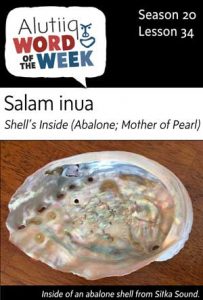 Salam inua–Shell’s Inside (Abalone; Mother of Pearl)
Salam inua–Shell’s Inside (Abalone; Mother of Pearl)
Salat inuat rirtut.–Shell insides are shiny.
The Pinto Abalone (Haliotis kamtschatkana) is a shallow-water, marine snail. It is one of eight abalone species that inhabit the Pacific coast of North America, and the only abalone that lives in Alaskan waters. It can be found from Alaska’s Yakutat Bay to Point Conception in southern California. This small abalone has an oval shell that can grow up to six inches long. It thrives in areas with kelp beds, a rocky sea floor, and currents, between the lowest limit of the daily tides to about 40 feet of water. Although the Pinto Abalone has an unremarkable, dull, tan or pink outer shell, the shell’s interior features a beautiful, glossy, blue-green nacre. This iridescent coating, also known as mother of pearl, is exceptionally strong.
Alaska Native artists prize the colorful, durable abalone shell. The Tlingit people have long used it to decorate clothing and jewelry. They wear abalone earrings, decorate blankets with abalone buttons, and once, fastened thin pieces of the shell to their faces with spruce gum. The Tlingit also inlay carvings with piece of abalone, lining many objects with shimmering pieces of shell.
Some of the abalone used in southeast Alaska was collected for food and raw material by Native residents. However, as abalone is found only on the outer western coast of southeast Alaska, and as Alaskan abalone has a smaller more brittle shell than California abalone, abalone was a major trade item along the northwest coast. Some of this material made its way to Kodiak.[xyz-ihs snippet=”Adsense-responsive”]At the Karluk One site, archaeologists recovered two pieces of abalone shell. The presence of abalone many hundreds of miles from its source illustrates the far-reaching trade networks that existed long ago. People traveled great distances to obtain valuable materials, materials that helped community leaders show both their wealth and ability to connect with distant people and places.
Source: Alutiiq Museum




